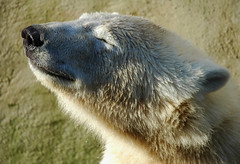 Besides changing the climate and environment for people around the world the loss of Arctic sea ice is destroying the habitats for polar bears. Recently we reported about polar bears swimming to Iceland trying to find food and land. And now scientists are reporting that the starving polar bears are desperately resorting to killing and feeding on other polar bears as their natural habitats are rapidly being destroyed by man-made global warming.
Besides changing the climate and environment for people around the world the loss of Arctic sea ice is destroying the habitats for polar bears. Recently we reported about polar bears swimming to Iceland trying to find food and land. And now scientists are reporting that the starving polar bears are desperately resorting to killing and feeding on other polar bears as their natural habitats are rapidly being destroyed by man-made global warming.
Unfortunately there seems to be no light in the tunnel for the polar bears. A new preliminary report from NASA shows that the sea ice at the Arctic continues to disappear and that the ice-levels this year has reached the second-lowest level on record.

Recommended Comments
There are no comments to display.
Join the conversation
You can post now and register later. If you have an account, sign in now to post with your account.